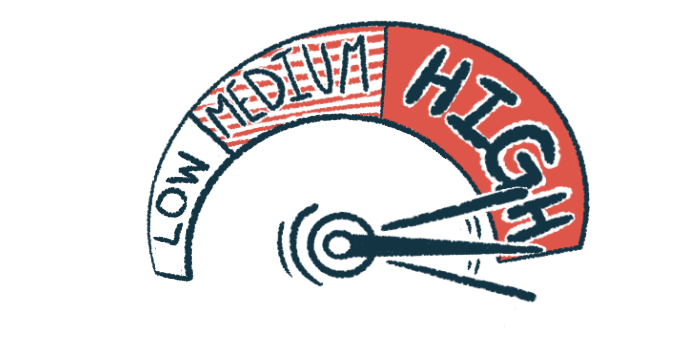New index can predict mortality at AAV diagnosis in non-obese patients
These early markers may help identify individuals at high risk, study says

Researchers in Korea have identified a new index that can predict all-cause mortality in non-obese people with antineutrophil cytoplasmic antibody (ANCA)-associated vasculitis (AAV).
The index accounts for blood levels of fatty molecules called triglycerides and blood sugar, as well as body mass index (BMI, a ratio of height and body weight). Combining this index, called triglyceride glucose and BMI, with age and the Birmingham vasculitis activity score (BVAS, a measure of AAV activity) resulted in even greater accuracy at predicting mortality in this subgroup of patients.
“Our findings provide evidence that these indices are reliable markers for the early identification of individuals at high risk of mortality,” researchers wrote.
The study, “New index using triglyceride glucose-body mass index for predicting mortality in patients with antineutrophil cytoplasmic antibody-associated vasculitis,” was published in the journal Frontiers in Medicine.
Higher mortality seen in people with AAV
AAV is a cluster of autoimmune diseases characterized by inflammation and damage to small blood vessels. The mortality rate of people with AAV is higher than that of those with other conditions associated with blood vessel inflammation, with cardiovascular disease (CVD) as a common cause of death.
As such, “more careful attention should be paid to patients with risk factors for all-cause mortality at diagnosis,” the researchers wrote.
The team of researchers previously showed that older men were at a higher risk of death, from any cause, than others with AAV.
The BVAS has been shown to predict CVD or CVD-related mortality in this patient population. A previous study found that increased insulin resistance — measured by the triglyceride glucose (TyG) index — at diagnosis predicted the development of cardiovascular disease in AAV patients.
Insulin resistance, a contributor to cardiovascular disease, is a condition in which cells no longer respond well to insulin and can’t properly use blood sugar, or glucose, to produce energy.
Another index, the triglyceride glucose-body mass index (TyG-BMI), was shown to predict insulin resistance in the general population. “However, to date, no study has evaluated the predictive potential of TyG-BMI for unwanted outcomes such as all-cause mortality, [cerebrovascular accidents], and CVD in AAV patients,” the researchers wrote.
Our findings provide evidence that these indices are reliable markers for the early identification of individuals at high risk of mortality.
78 non-obese AAV patients included in study
To address this knowledge gap, the researchers investigated whether TyG-BMI could be used to predict all-cause mortality in non-obese AAV patients. Obese patients were excluded to minimize the effect of BMI on mortality.
A total of 78 non-obese people who were diagnosed with AAV at a clinic in Korea from October 2000 to May 2021 were included in the analysis. Patients were a median age of 54.3 years at diagnosis and 20.5% were men. Most of them (53.8%) had microscopic polyangiitis, the most common type of AAV.
Over an average follow-up period of 36.6 months (about three years), five patients (6.4%) died, six (7.7%) had cerebrovascular accidents, and four (5.1%) had cardiovascular disease.
Results showed that the TyG-BMI index was able to predict all-cause mortality in non-obese AAV patients with 73% accuracy. However, it was not good at predicting disease relapse, cerebrovascular accidents, CVD, or kidney failure.
A significantly higher proportion of patients with a TyG-BMI index equal or above a cutoff value of 187.74 died relative to those with a score below cutoff (23.1% vs. 3.1%). This represented a nine times higher risk for all-cause mortality among patients with a higher TyG-BMI index value.
Given that further analyses showed that age, BVAS, and a TyG-BMI index score equal or above 187.74 were associated with all-cause mortality, the researchers developed a new index using TyG-BMI (NITGB) that included all three variables.
NITGB index found to be superior at predicting all-cause mortality in patients
The NITGB was found to be superior to the TyG-BMI index at predicting all-cause mortality — with an accuracy of about 93%.
Patients with an NITGB score equal to or higher than a cutoff value of 27.36 showed a significantly increased rate of death (80%) than those with a score below cutoff (1.4%). This corresponded to a significantly higher risk of death, by 284 times, due to any cause.
“For the first time, we demonstrated the abilities of TyG-BMI and a new index using TyG-BMI (NITGB) to predict all-cause mortality in non-obese AAV patients,” the researchers wrote, adding that “the predictive ability of NITGB is greater than that of TyG-BMI.”
This study enabled the development of biomarkers or indices that can predict all-cause mortality at the time of AAV diagnosis in non-obese patients, according to the researchers.
The small number of patients and the study’s retrospective nature — which did not allow control of factors that could affect the indices or all-cause mortality — were pointed out as limitations of the study. Also, the fact that the study was limited to Korean patients does not allow its direct extrapolation to other ethnicities.
“In the near future, we will conduct another study including AAV patients with diverse ethnicities and believe that that study will validate the results of this study and provide more reliable information on the clinical implications of NITGB in AAV patients,” the scientists wrote.








